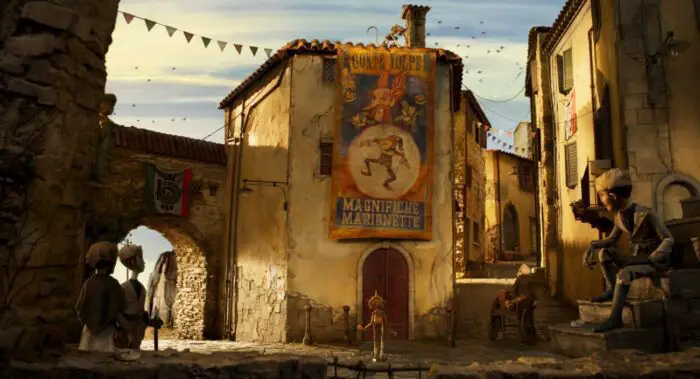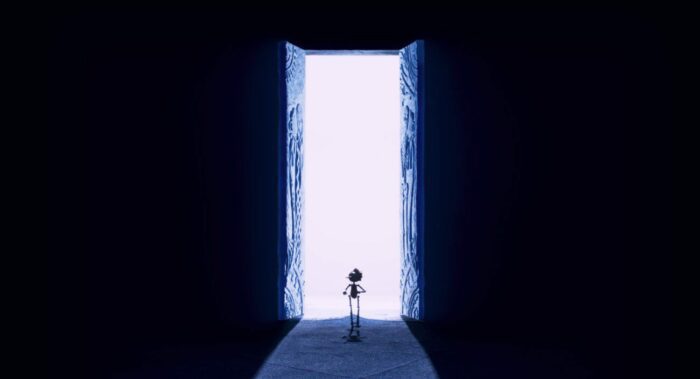This is how you remake a film. Guillermo del Toro’s Pinocchio reimagines Pinocchio with a dark spin that puts Disney’s recent live-action rendition to shame. The key to remaking a story is to do something other than a shot-for-shot remake with newer technology. Recreating the same tale everyone has seen for decades is a tireless exercise in homage. The shower killing in Psycho doesn’t have the same effect when recreated, nor does the Whale from Pinocchio. Computer Generated Imagery (CGI) is a slang term for a reason. The computer can’t replicate the beauty of something drawn by hand or painted on a model. Over the years, CGI has oversaturated cinema’s market, drawing mixed results in the final product. Most Marvel films look like Sharkboy and Lava Girl, while television shows like The Mandolorian provide stunning visual effects for a small screen. Therein lies the problem. CGI rarely works for the big screen anymore.
Not Meant For A Small Screen

By taking a note from The Nightmare Before Christmas, Guillermo del Toro utilizes stop-motion animation to his fullest extent. Nightmare is a film meant to be seen on the largest screen possible so every little detail of its hand-painted model can be gazed in stunning detail. To this day, I recall seeing The Nightmare Before Christmas with a sense of amazement from its visuals I never felt on the television screen. If you can see Guillermo del Toro’s Pinocchio on the big screen, then for the love of Jiminy Cricket do it! With the assistance of a co-director (Mark Gustafson) with a background in animation, the dual filmmakers create a dark version of the classic fairy tale that’s more appealing to adults than children.
Published in 1883, Carlo Collodi’s Pinocchio takes place in a nondescript year in each adaption, which is likely placed around the same period. Guillermo del Toro’s Pinocchio takes an entirely different approach placing its tale in World War II Italy. In the middle of the conflict is Geppetto (David Bradley) along with his son Carlo who live blissfully together. Until the Nazi bombers come to drop an explosive on the little boy, exterminating Geppetto’s dreams. Geppetto hits the bottle weeping over his son’s grave to reconcile his pain. As time moved on, Gepetto never did. One fateful day during an act of anger, Gepetto constructs the wooden child that would change his life indefinitely.
Pinocchio Matured

Free from Disney’s family-safe strings, del Toro is free to make a Pinocchio film unlike any other. Mickey Mouse wouldn’t be fond of del Toro’s vision. Nazis aren’t on the table, nor is religion. A direct allegory to Jesus’ resurrection is drawn to symbolize Pinocchio’s birth, a euphemism that plays more like a respawning video game character than the son of God. Pinocchio gets killed about as many times as Michael Myers, yet he keeps coming back.
Geppetto’s occupation of painting blood on the crowns of Christ is a bit too extreme an allegory for the film’s own good. Why is Pinocchio like Jesus? Is it the similarity to God’s son, which he’s brought back to life? Aside from the obvious parallel to Christ’s rise from the grave, it’s difficult to interpret where del Toro was going with religion. Still, it’s a nitpick among so many elements that work spectacularly. When the film’s mature themes resonate, they do so with a heft we haven’t felt since watching the 1940 original as children.
As kids, Pinocchio’s idea of becoming a real boy relates to our identities growing up. Children don’t know who they are and what’s culturally appropriate. The importance of family and education is placed in the story, helping young ones understand how the world works and why we must seek our individualism. The story feels as lively as a block of wood when watching Pinocchio being told to death over decades. Guillermo del Toro’s Pinocchio has elements of the same story but with more embellishment on Gepetto to provide a level of complexity never seen before.
Geppetto’s Heart

Most renditions of Pinocchio imply that Gepetto once had a son; thus, Pinocchio serves his grief. In Guillermo del Toro’s Pinocchio, the motivation for making the doll is clear as day. Where Geppetto could come across as a sweet old man with no emotional intricacy, Geppetto, in this version, is a grizzled lost soul. He’s more human than before.
To ease the pain of losing his family, Geppetto plunges into alcoholism. His creation of Pinnochio plays like Doctor Frankenstein being unleashed in an intoxicated rage. Geppetto is flawed. His grief defines his motivation. Not only for losing a son but for being a good man, Geppetto deserves a child. He’s a kind soul who doesn’t inflict his pain on others other than himself.
Pinocchio is defined by his naiveté. Being a child made from magic, Pinocchio doesn’t get the chance to develop the concept of anything. It’s unclear to him whether putting his feet in fire is dangerous or what war even is. Being as reckless as he is, Pinocchio grabs the attention of the Mussolini-loving troops placing Geppetto’s life in jeopardy. Rather than automatically loving his son brought to life by a miracle, Geppetto gets short with the boy yet never rejects him. All over again, Geppetto must learn how to become a father.
Through Geppetto’s journey from grief to the pains and pleasures of raising Pinocchio, a searing intrinsic bond is connected to the audience. Guillermo del Toro’s Pinocchio isn’t just a visually appealing dark rendition of Carlo Collodi’s timeless story. It’s also a deeply effective tale about maturity and parenting that understands why Pinocchio’s kinship between father and son is universally praised.
Tim Burton for Adults
As honest trailers put it, Guillermo del Toro is “Tim Burton for adults.” Not simply in terms of blood or nudity. Del Toro’s films exceed the basic motifs of a Burton narrative. Unlike most Tim Burton pictures, the plot isn’t solely reliant on its visuals for lack of nuance. The story of the societal outcast who learns to accept themselves for who they are can be interpreted in limitless ways. Some can be repetitious, like Tim Burton’s later filmography, while others can be baffling (casting Pauly Shore as Pinocchio in 2022) or horrifying (Roberto Benigni casting himself as Pinocchio). Never in a million years did I think this story could still work—no matter what talent you put behind the camera. Guillermo del Toro proves the naysayers wrong with an adaptation that will spark kids’ curiosity and leave a lump in parents’ throats.
Pinocchio is currently in select theaters. You can find the listings here https://guillermodeltorospinocchiomovie.com and will be on Netflix December 9th https://www.netflix.com/title/80218455


